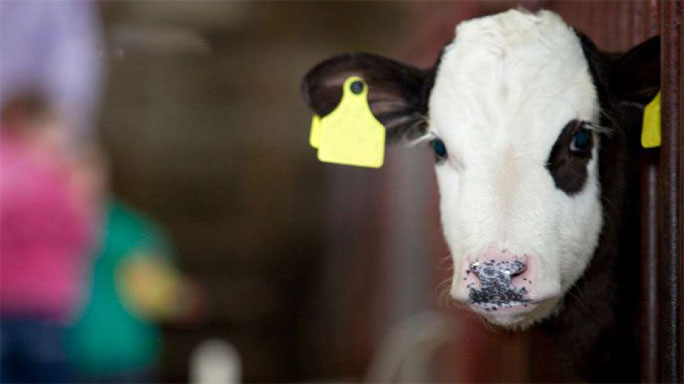Calf Housing - What adaptations can you make to your existing calf shed?

Small adaptations can help deliver major improvements to your calf shed. For any calf shed we want to try to control moisture and air movement.
There are several things farmers can do to assess their current housing facilities. To assess air movement within a calf shed, crouch down at calf level in the pen to check if you can get a smell of ammonia, or think back to what the shed was like last year. If you can get a smell then the air movement in the shed is not good enough, which in turn means bacteria and airborne contaminants are not moving away from the calf. We also have to try to prevent draughts within sheds. If calves are lying randomly throughout a pen it is a good sign that there are no draughts at calf level. However, if they are avoiding certain areas it may require further inspection
Warm environment
The lower critical temperature of a calf is the temperature below which an animal has to burn additional energy to keep warm. For calves over 4 weeks of age, this is below 15C. Air movement of less than 0.2m/s is described as draught free. Providing calves with a good deep bed of straw while protecting them from draughts will help them stay above their lower critical temperature. One option for large openings in sheds is to install a windbreaker. Where you are installing one that can stay fixed for the winter then it can be ratcheted into place. The void area of a windbreaker can vary, but they are generally 20% to 25% which will still ensure a good movement of controlled air, while preventing draughts. Where calves are housed in mono-pitch sheds with an open front then a fixed windbreaker may not be an option. There are a few different options that can be explored here, either a sliding windbreaker that would be pulled across between two stanchions, or a windbreaker on a roller. The third option is to install a full windbreaker roller door.
Yorkshire boarding
The other options that more farmers are looking at installing to provide inlet ventilation for calf sheds are Yorkshire boarding and spaced boarding. There can be a massive variation in the void area of vented sheeting, 5% void all the way up to 18% void, which can mean a major difference in the amount of fresh air that enters a shed.
Ventilation options
Spaced boarding is made up of a single line of boards with a gap no larger than 25mm between the boards. Different sized boards can mean a different void area. For example, a 100mm board and a 25mm gap will give a void area of 20%. If we want to further increase ventilation we can use a 75mm board and a 25mm gap; this gives us a void area of 25%. Spaced boarding may be useful on a sheltered side of the shed. However, for more exposed sites then Yorkshire boarding should be used. It will still allow air to move through while preventing driving wind and rain from entering the shed. Yorkshire boarding is made up of two rows of vertical boards offset on either side of a purlin. Firstly the maximum gap that can be left between the two lines of boards is 50mm. If this is any larger, rain may be able to get through. The recommendation is to use a 150mm board and a 40mm gap. Using this design will still provide a 20% void area in your boarding. To remove vented sheeting, supply and fit Yorkshire boarding is approximately €70/linear metre, for a 2m high section, as quoted by a builder. This would equate to a cost of €336/bay of a shed. To remove vented sheeting, supply and fit spaced boarding costs approximately €50/linear metre, again for a 2m high section. This would equate to a cost of €240/bay of a shed.
Moisture
Reducing the moisture in pens should also be examined. The best way to do this is to ensure a good floor slope in pens with drains running along the front of pens. Installing a floor slope with a 1:20 fall will help to bring moisture quickly to the front of the pen and away from calves. To remove the current concrete floor and replace with a 1:20 fall costs approximately €35-40/square metre. For a 4.8m by 4.8m pen this would cost approximately €864/pen. It is important that the old pen is dug up for the front 1.5m at least to ensure the new concrete can be well binded in.
Fan and duct
A fan and a duct to ensure adequate ventilation on a still day is required for most calf sheds in Ireland. However, for an existing shed they may be a very cost-effective way of improving airflow. For sheds with low roofs in particular it may be the only option to improve airflow. Running costs could be approximately €90-113/year depending how much it is used. However, where a fan and duct system is being used then calf jackets for the first few weeks of life may also be required to prevent chills.
You can view the Dairy Heifer Rearing Programme here
Browse GAIN calf feed here: https://www.glanbiaconnect.com/shop/category/Calf
For more information, please contact your local Glanbia Ireland Representative, Branch or visit glanbiaconnect.com
Tagged with: Dairy